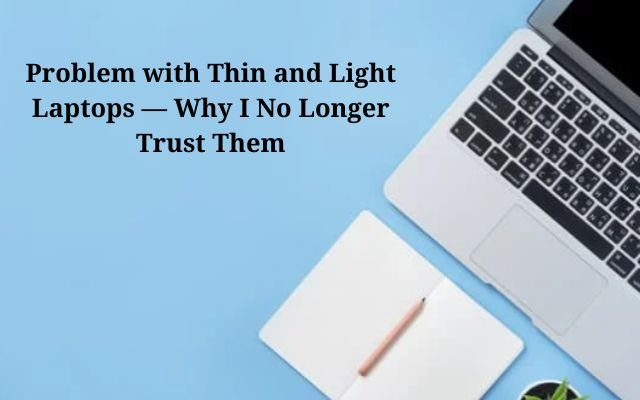Thin and Light Laptops Failed Me — Here’s What You Should Know
Thin and light laptops look great but come with problems like poor battery, weak performance, and costly repairs. Here's why.

Thin and light laptops always look so appealing at first. They’re marketed as the perfect mix of performance and portability — easy to carry, stylish, and powerful enough for daily tasks. I believed that too.
I thought buying a slim, lightweight laptop would make my work easier, especially since I travel a lot and don’t like carrying heavy devices. But over time, I realized these thin designs come with hidden compromises.
The more I used them, the more frustrated I became. Heating issues, poor battery life, weak build quality, and limited upgrade options became constant problems.
It felt like I was sacrificing reliability just to have a laptop that looked good and felt light in my bag.
After facing these issues more than once, I’ve finally decided I can’t trust thin and light laptops anymore — not when better, more durable options are available that actually deliver the performance I need.
Why Thin Laptops Struggle with Battery Life
A smaller laptop always means there’s less space for a big battery. Manufacturers try to solve this by using power-efficient chips and software tweaks to make the battery last longer. Sometimes, it works for light tasks. But there’s only so much they can do when the battery itself is small.
For example, the 2024 Dell XPS 13 is known for having good battery life for its size. It handles web browsing, writing, and other light tasks quite well. But when you compare it to a bigger laptop like the MacBook Pro 16-inch, the difference is huge. The MacBook simply has more space inside for a larger battery, which means it lasts much longer, especially when doing heavy tasks.
Thin and light laptops do fine when you’re just watching videos or checking emails. But when you push them harder — like editing videos or running demanding apps — the battery drains quickly. That’s the reality of these ultraportable machines. No matter how efficient the chip is, the small battery holds them back.
Why Thin Laptops Can’t Perform Well
Thin and light laptops have a smaller body, which means there’s less space inside for proper cooling. This limits how much power the laptop can use before it gets too hot. Once the heat builds up, the laptop has to slow down to cool itself, which affects performance.
Take Apple’s MacBook Air M2 as an example. It has no fan at all, which keeps it completely silent. That sounds great, but it also means the laptop can’t handle heavy tasks like video editing or gaming for too long. When it gets hot, the MacBook Air slows down to protect itself. This is called thermal throttling.
Some thin laptops, like the Dell XPS 13 and HP Spectre x360, come with small fans to help with cooling. They handle tasks better than fanless laptops, but because the cooling system is still small, they struggle with performance during long or demanding tasks. After a while, they also start to heat up and slow down.
Newer chips like Intel’s Core Ultra, Apple’s M3 and M4, and Qualcomm’s Snapdragon X Elite are designed to be more power-efficient. They help with heat and performance, but even these chips can’t fully solve the problem. The truth is simple — thin laptops just don’t have enough space for powerful cooling. That’s why they can’t maintain high performance for long periods without heating up.
Why Thin Laptops Compromise on Keyboard and Trackpad
When laptop makers try to make laptops super thin, the keyboard and trackpad often get worse. There’s less space, so the keys become shallow and don’t feel good to type on.
Apple’s old butterfly keyboard is a good example. It was very thin but had lots of problems. The keys got stuck or stopped working. Apple later fixed it, but many thin laptops still have keyboards that feel weak and are not very durable.
Trackpad has issues as well. Because there isn’t enough space in certain tiny computers, the trackpad feels rigid or difficult to use. Gestures and clicking don’t function properly.
It might not appear to be a major issue at first. But with time, it becomes incredibly unpleasant if you use the trackpad or type a lot.
Thin Laptops Have Limited Ports
Thin laptops are not just light — they also have fewer ports. To keep the design slim, companies remove important ports. This means you need to use dongles or adapters to connect basic things.
For example, the MacBook Air M1 I’m using right now has only two USB-C ports and a headphone jack. If I want to charge it, use a USB drive, and connect a monitor at the same time, I can’t. I need a dongle or a hub.
Bigger laptops like the Lenovo ThinkPad X1 Extreme or the MacBook Pro 16-inch still have more ports. They come with USB-A, HDMI, and SD card slots, which makes them easier to use.
Dongles are not just annoying — they cost extra, are easy to forget, and can get lost. If you don’t have one when you need it, you’re stuck and can’t finish your work.
- The Best Free Transcription Service You’ve Been Waiting For
- I Tried Free Streaming Services — Now I’m Thinking About Canceling Netflix
- 5 Key Limitations: Why AI Search Tools Won’t Overtake Classic Google
Fixing Thin Laptops Is a Big Problem
Thin laptops feel like they are made to be replaced, not repaired. It’s not because they are cheap, but because of how they are built. Many of them have the RAM and storage soldered to the motherboard. This means you can’t upgrade them later if you need more memory or space. If you run out of storage or need better performance, you have to buy a new laptop.
The battery is also hard to replace. Some thin laptops glue the battery inside instead of using screws. This makes it difficult and expensive to change battery when it gets weak.
Some companies also don’t allow third-party repair shops to fix their laptops. You’re forced to go to their service centers which costs more and takes more time.
Thin laptops look nice but they have too many problems. They get hot, have poor battery life, and don’t perform well in heavy tasks. The keyboards are shallow, ports are limited, and you always need extra dongles.
That’s why I don’t trust thin and light laptops anymore. A little extra thickness is better. It lasts longer, works better and is easier to fix.



